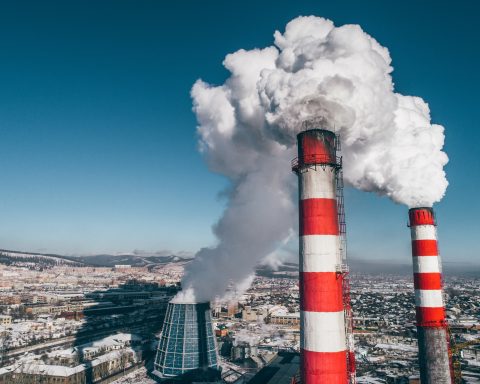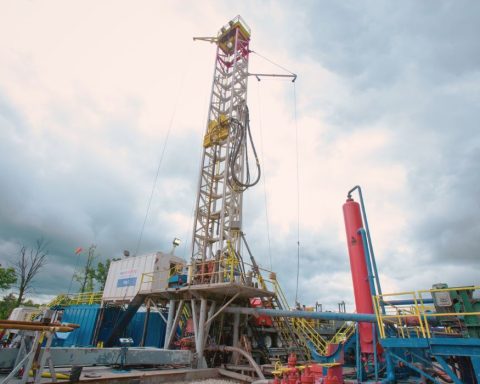For more than a century, Algoma Steel forged its namesake in coal-fuelled blast furnaces at its Sault Ste. Marie plant in Northern Ontario. Now, if all goes according to plan, Canada’s second-largest steelmaker will be forging all that metal in electric arc furnaces by year-end.
The company, which supplies sheet metal to the auto industry, says the move will cut carbon emissions from production by approximately 70%, a reduction equivalent to removing more than 900,000 cars from the road each year. This is good news for the climate and for the auto sector. As the second-largest consumer of steel after buildings and infrastructure, the auto industry needs low-carbon steel products if it’s going to meet its own emissions targets.
Virtually every vehicle on wheels is made primarily of steel. That’s a problem since the steel industry is one of the highest emitting sectors of the economy, responsible for 7% of global greenhouse gas emissions, mostly due to its reliance on coal. Currently, tailpipe emissions are responsible for the bulk of the pollutants from road transportation. But that’s changing as uptake of electric vehicles continues apace. EVs don’t produce exhaust and, in many places, the grid is increasingly generating power from renewable or other green power sources.
Increasingly, attention is turning to the carbon footprint of an automaker’s supply chain and all the materials that go into building a vehicle. Of those materials, steel makes up the largest proportion at 60%. Indeed, the embedded, or production, emissions of an electric car will likely account for around 60% of total life-cycle emissions by 2030, with steel making up anywhere from 16% to 27% of that, according to the EU-based advocacy group Transport and Energy.
Auto sector takes small steps toward green steel
To date, only a handful of automakers have pledged to increase their use of either fossil-free steel or steel with reduced carbon intensity by 2030. BMW announced its procurement of “carbon-reduced” steel supplied by H2 Green Steel, based in Sweden, and has partnered with Salzgitter AG to receive “low-carbon steel” in 2026.
Volkswagen has signed a memorandum of understanding with Salzgitter AG to procure carbon-reduced steel starting at the end of 2025; Volvo has pledged that 50% of its steel purchases in 2030 will be lower in emissions intensity compared to current levels. And General Motors announced a supply agreement with U.S. Steel and ArcelorMittal for reduced carbon steel. (Algoma will in all likelihood also supply the automotive industry with green steel given that approximately 30% of its products go to the auto sector.)
The climate impact of shifting to low-carbon steel is profound. If, as recommended by groups such as Transport and Energy, European automakers replace 40% of the steel used in their manufacturing process by 2030, carbon dioxide emissions from the production of cars plummets by 6.9 megatonnes, equivalent to the annual GHGs emitted from 3.5 million fossil fuel cars. Switching to 100% green steel in new cars by 2040 will reduce emissions equivalent to taking 8.1 million gas-powered cars off the road.
In a recent report, the International Council on Clean Transportation (ICCT) acknowledges the importance of the public announcements made by some of the biggest players in the auto industry while also pointing out that “among major automakers selling vehicles in Europe and North America, only four have pledged to procure any fossil-free steel by 2030.” The report authors note that those commitments apply to a mere 2% of the global steel used by all these major automakers. Adding in “commitments to procure steel with reduced GHG emissions,” they write, “increases the share of cleaner steel to 4% of all automotive steel.”
The authors further argue that the auto sector is in a unique position to push the steel industry to decarbonize. “Automakers have significant purchasing power,” says Marta Negri, an associate researcher at ICCT and lead author of Which Automakers Are Shifting to Green Steel? “They can influence demand for green steel.”
Steel’s great big carbon footprint
Around 75% of steel worldwide is manufactured using coal-fired blast furnaces. According to the International Energy Agency’s Net Zero Emissions scenario, the steel industry must reduce its carbon output by 25% by 2030 to achieve climate neutrality by 2050 – and the sector is nowhere close to being on track.
On the bright side, the carbon intensity of steel production can drop considerably through deployment of low-carbon technologies and resource efficiency. For starters, the coal-blast furnaces can be replaced with electric ones, like Algoma’s, reducing emissions by as much as 95%. Scrap steel can be incorporated at much higher volumes than is done currently, and green hydrogen power is being actively explored for its potential as a cost-effective energy source.
Transportation, in turn, leaves a massive carbon footprint. Road transport in Canada is the second-largest source of carbon pollution after oil and gas, responsible for 22% of the country’s overall emissions. Electrifying road mobility is essential to meeting Canada’s international obligation under the Paris Agreement to limit global warming to below 1.5°C. Steel’s importance in the auto sector is becoming increasingly visible in part because more of it is needed in electric vehicles – due to their large battery units – than in combustion vehicles.
To see a significant dent in steel-related emissions, carmakers will need to employ a combination of strategies. “Green steel can be a competitive advantage for an automaker,” Negri notes. “Some companies are exploring this and being very vocal about their green steel use.”
Still, the road to industrial decarbonization is long. “We’d like to see more ambition,” Negri adds. “Two-thirds of the automakers we analyzed haven’t made any commitments to purchase low-carbon or fossil-free steel. And we need to see that the commitments made are carried through.”
Victoria Foote is a writer and editor who specializes in clean energy and climate.







